Quartzite: Properties, Colors, Uses
Quartzite is a metamorphic rock primarily composed of quartz, formed from sandstone through natural heat and pressure over time. It is known for its durability, hardness, and attractive appearance, making it a popular choice for countertops, flooring, and wall cladding in both indoor and outdoor settings.
What is quartzite?
Quartzite Definition
Quartzite: A non-foliated, metamorphic rock composed primarily of interlocking quartz grains. It forms through the metamorphism of sandstone, a sedimentary rock rich in quartz. This process involves subjecting sandstone to high pressure and temperature conditions, typically within orogenic belts during tectonic compression. The intense heat and pressure cause the silica (SiO₂) within the sandstone to recrystallize, eliminating original grain boundaries and creating a dense, tightly packed network of quartz crystals. This recrystallization process transforms the sandstone into a remarkably strong and enduring rock with very low porosity.
 |
| Quartizite |
Quartzite Texture
Quartzite has a granular texture, meaning quartzite is a medium-to fine-grained rock with a mosaic of fused quartz crystals. The original quartz grains in the sandstone would have had pore spaces between them, but metamorphism causes these to be infilled as the quartz crystals grow. Metaquartzite is a ‘sugary’ rock, which often lacks structures related to the original sedimentary rock.
Quartizite the sedimentary rock
Quartzite can also refer to sedimentary sandstone converted to a much denser form through the precipitation of silica cement in pore spaces. Orthoquartzite is a very hard, but unmetamorphosed sandstone. It's essentially a sandstone where the quartz grains are cemented together with a significant amount of secondary silica, This cementation process (called diagenesis) happens at relatively low temperatures and pressures, without reaching the metamorphic stage. Think of it as a very tightly packed sandstone where the spaces between grains have been filled with additional quartz.
Metamorphic quartzite is the "true" quartzite, also called Metaquartzite.
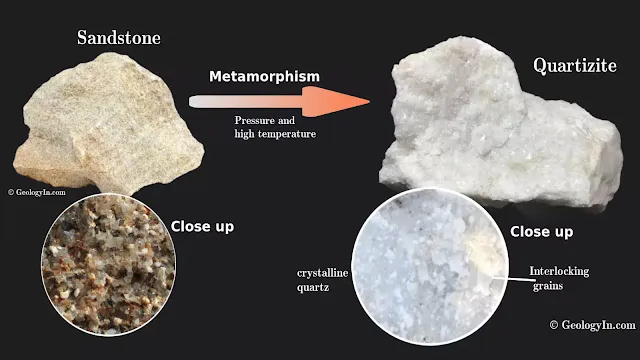 |
Quartzite forms when sandstone is subjected to high heat and pressure |
Quartizite Characteristics & Properties
Quartzite possesses several characteristics and properties that distinguish it as a unique and valuable natural stone material. Here are some key characteristics and properties of quartzite:
Composition: Quartzite is primarily made of the mineral quartz, typically exceeding 90% by volume. In its original form, it starts as sandstone, which is itself composed of quartz grains. Geologists typically say a rock needs to be at least 80% quartz to be classified as quartzite. Trace amounts of other minerals like hematite, iron oxide, and clay can also be present.
Hardness: Quartzite is one of the hardest natural stones, with a Mohs hardness of 7. This makes it highly resistant to scratching and wear.
Density: Quartzite is relatively dense, with a specific gravity ranging from 2.65 to 2.90. Its density contributes to its strength and durability, making it suitable for various structural and decorative applications.
Durability: Quartzite is one of the hardest natural stones, making it highly resistant to scratching, chipping, and wear. This property makes it a popular choice for countertops, flooring. Quartzite is also very resistant to weathering and corrosion. It is not affected by most acids or chemicals, making it a good choice for outdoor use.
Heat Resistance: Quartzite is heat-resistant, making it a practical choice for kitchen countertops and fireplace surrounds. It can withstand exposure to high temperatures without sustaining damage or discoloration.
Water Resistance: While quartzite is not entirely impervious to water, it has a low absorption rate due to its dense composition. This makes it suitable for use in wet areas such as bathrooms, showers, and pool surrounds when properly sealed.
Quartizite Colors
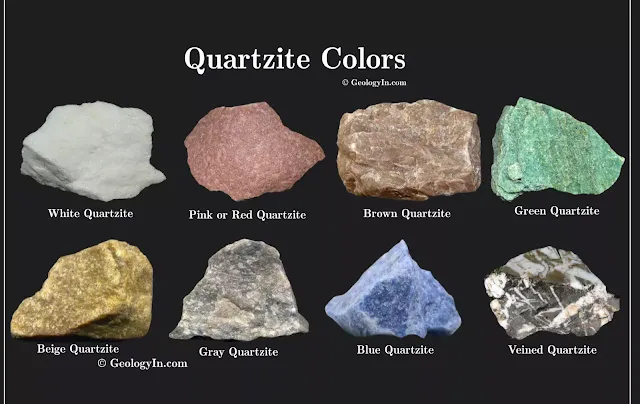 |
Quartizite Colors |
White Quartzite: The presence of other minerals during its formation causes the white color in Quartzite. This is a popular choice for countertops and flooring due to its clean and elegant look. Taj Mahal quartzite is a well-known example, featuring a creamy white background with subtle gray veining.
Gray Quartzite: The presence of trace minerals like mica or feldspar can influence the gray tones in Quartzite. Gray quartzite offers a sophisticated and timeless look. It can also have variations in shade and veining patterns. Bianco Antico quartzite is a popular example, featuring a pale ivory base with dramatic brown and gold veins.
Beige Quartzite: Iron oxides can sometimes impart a beige color to Quartzite. Beige quartzite provides a warm and earthy feel to a space. Super White quartzite is an example, featuring a cool white base with subtle golden veins and a touch of shimmer.
Green Quartzite: Chlorite, a green mica mineral, is the primary culprit behind the stunning green hues of Green Quartzite. Muscovite (white mica) and biotite (black mica) can add flecks or streaks of white, gray, or black to quartzite. Green quartzite can add a touch of nature-inspired elegance. Verde Fondu quartzite showcases a deep forest green base with contrasting white veining.
Pink or Red Quartzite: The presence of iron oxide in its mineral composition is what causes the pink -reddish color in Quartzite.
Blue Quartzite: Blue quartzite is a rarer find, but it can add a stunning pop of color. The blue color can be caused by traces of minerals like glaucophane or azurite.
Brown Quartzite: Iron oxide is also responsible for the brown tones found in Quartzite. Brown quartzite can range from light to dark shades, and can add a touch of warmth and richness. Golden Macaubas quartzite, with its warm golden hues and flecks of mica, is a beautiful example.
Multicolor Quartzite: A combination of different minerals can result in a multicolor Quartzite. Some quartzite varieties feature a blend of different colors, creating a truly unique and eye-catching appearance. Fusion quartzite, featuring a dramatic swirl of white, gray, and black with hints of gold, is a popular example.
Veined Quartzite: Veined quartzite is a type of quartzite that features distinct streaks or swirls of color running throughout the stone. These veins are caused by the presence of minerals other than quartz during the metamorphic process that forms quartzite. The colors and patterns of the veins depend on the specific minerals present.The veining patterns in quartzite can be linear, swirled, or spiderweb-like, adding a unique touch to each slab. These variations contribute to the fact that no two pieces of veined quartzite will ever be exactly alike.
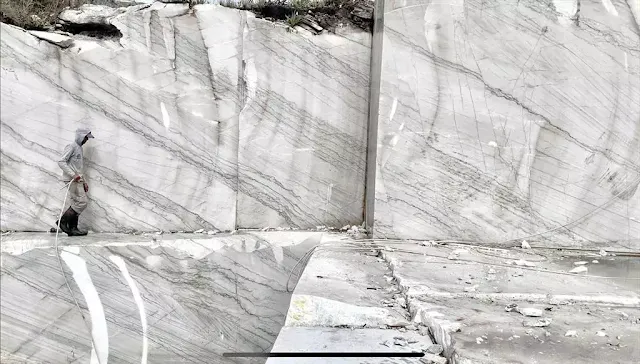 |
| Quartzite quarry - Brazil |
Uses and Applications of Quartizite
Quartzite boasts a variety of applications due to its unique properties of hardness, durability, and aesthetic appeal. Here's a breakdown of its key uses:
Construction Applications
Construction aggregate: Crushed quartzite serves as a valuable component in road construction and railway ballast due to its exceptional resistance to abrasion.
Quartzite finds use in construction as:
- Road aggregate: It provides a strong and stable base for roads.
- Railway ballast: The crushed rock offers stability and drainage for railroad tracks.
- Concrete aggregate: Quartzite strengthens concrete mixtures.
Decorative stone: The beauty and resilience of quartzite make it a popular choice for architectural and design purposes. It finds applications in:
- Wall coverings: Cladding both interior and exterior walls.
- Flooring: Offering a hard-wearing and aesthetically pleasing surface for floors.
- Countertops: Gaining popularity in kitchens due to its superior stain and scratch resistance compared to some other natural stones.
- Stair treads: Providing a durable and slip-resistant surface for stairs.
Industrial applications
Silica source: High-purity quartzite serves as a source material for the production of:
- Ferrosilicon: An alloy of iron and silicon used in steel production.
- Industrial silica sand: Employed in various industrial processes like glass manufacturing.
- Silicon and silicon carbide: Essential materials in the electronics industry.
Historical toolmaking: While less common today, quartzite was used in prehistoric times for crafting stone tools due to its hardness.
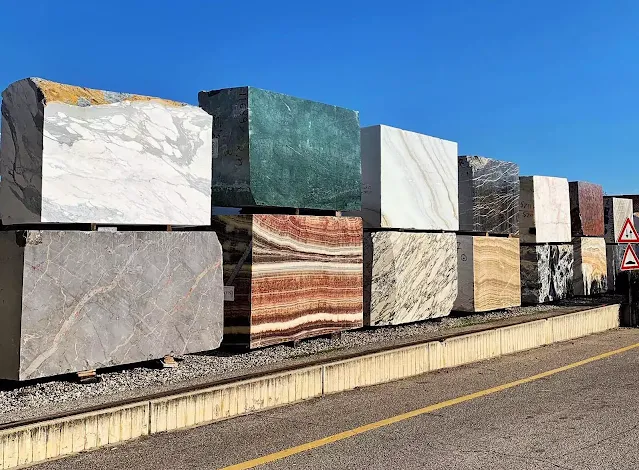 |
| Blocks of quartzite and marble |
Quartzite Occurrence and Distribution
Quartzite is a metamorphic rock that forms when sandstone is subjected to high heat and pressure. Quartzite is a widely distributed rock found on continents around the world, particularly in areas with ancient mountain ranges or exposed Precambrian basement rock.
Distribution
Mountain belts: Due to the immense pressure and heat associated with mountain formation, quartzite deposits are frequently found in areas with historical or ongoing mountain building processes. The Himalayas, Andes, Alps, and Appalachian Mountains are all examples.
Precambrian cratons: Precambrian cratons are remnants of Earth's earliest continents. These ancient and stable areas often have exposed basement rock, which can include quartzite formed during the Precambrian era (over 2.5 billion years ago). Examples include the Canadian Shield, the African Craton, and the Australian Craton.
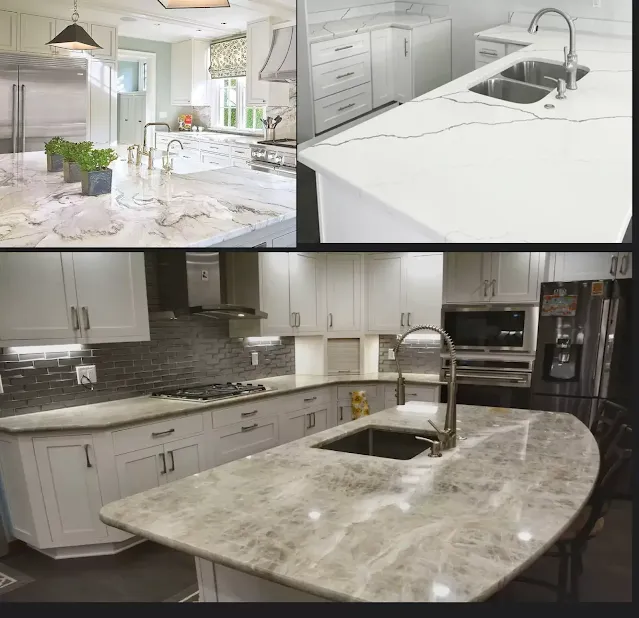 |
| Quartzite countertops |
Specific Locations (Examples)
North America:
- Appalachian Mountains (extensive white quartzite deposits)
- Baraboo Range, Wisconsin (pink quartzite)
- Sioux Quartzite, South Dakota (pink quartzite)
South America:
- Andes Mountains (various quartzite colors, including red)
- Wankane Formation, Peru (red quartzite)
Europe:
- Scottish Highlands (Cambrian quartzite peaks)
- French Alps (white quartzite)
- German Central Uplands (quartzite deposits)
Asia:
- Himalayas (abundant quartzite)
- Ural Mountains, Russia (white, pink, and green quartzite)
Africa:
- Atlas Mountains (folded and faulted quartzite formations)
- Cape Fold Belt, South Africa (some of the world's oldest quartzite)
Australia:
- Flinders Ranges (impressive quartzite ranges)
- Northern Territory (including quartzite caves of Uluru)
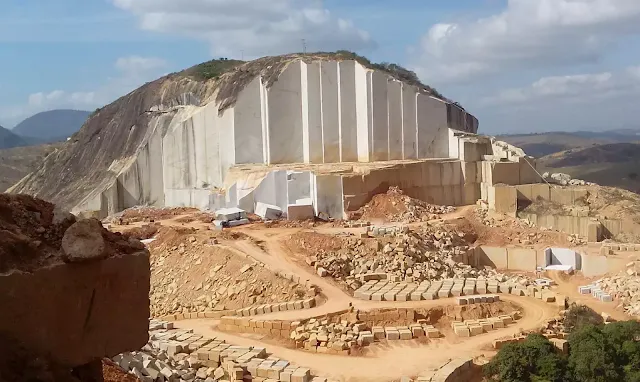 |
This quartzite outcrop showcases the contrast between a freshly exposed section and the weathered surface. |
Conclusion
Quartzite is a metamorphic rock resulting from the transformation of sandstone under high pressure and temperature. Its exceptional strength, durability, and diverse color varieties make it a valuable material with various industrial and architectural applications. Understanding the composition, formation, and geological significance of quartzite enriches our comprehension of Earth's geological processes and aids in the advancement of various technological endeavors.
Read also:
Gneiss: Formation, Types, Composition, Uses
Schist: Formation, Uses and Types of Schist
Soapstone: Formation, Properties and Uses

%20(1).webp)






